MGT320 Assessment 1: Ethical Behavior Article Analysis Report
VerifiedAdded on 2022/08/30
|9
|1690
|15
Report
AI Summary
This report provides a comprehensive analysis of an article concerning ethical behavior in business organizations, focusing on the arguments presented, strengths, and weaknesses of the piece, and the ethical approaches discussed. The analysis isolates key arguments and findings from the article, critically evaluates them within the context of ethical frameworks, and supports the evaluation with research from academic literature. The report examines the relationship between employees, management, and ethical practices, addressing the challenges of maintaining ethical standards in profit-driven environments. It also explores various ethical approaches, including teleological, deontological, emotive, moral rights, and justice approaches. The report concludes by summarizing the key insights and the importance of ethics in modern firms, highlighting the contradictions and influences that shape ethical behavior within organizations.
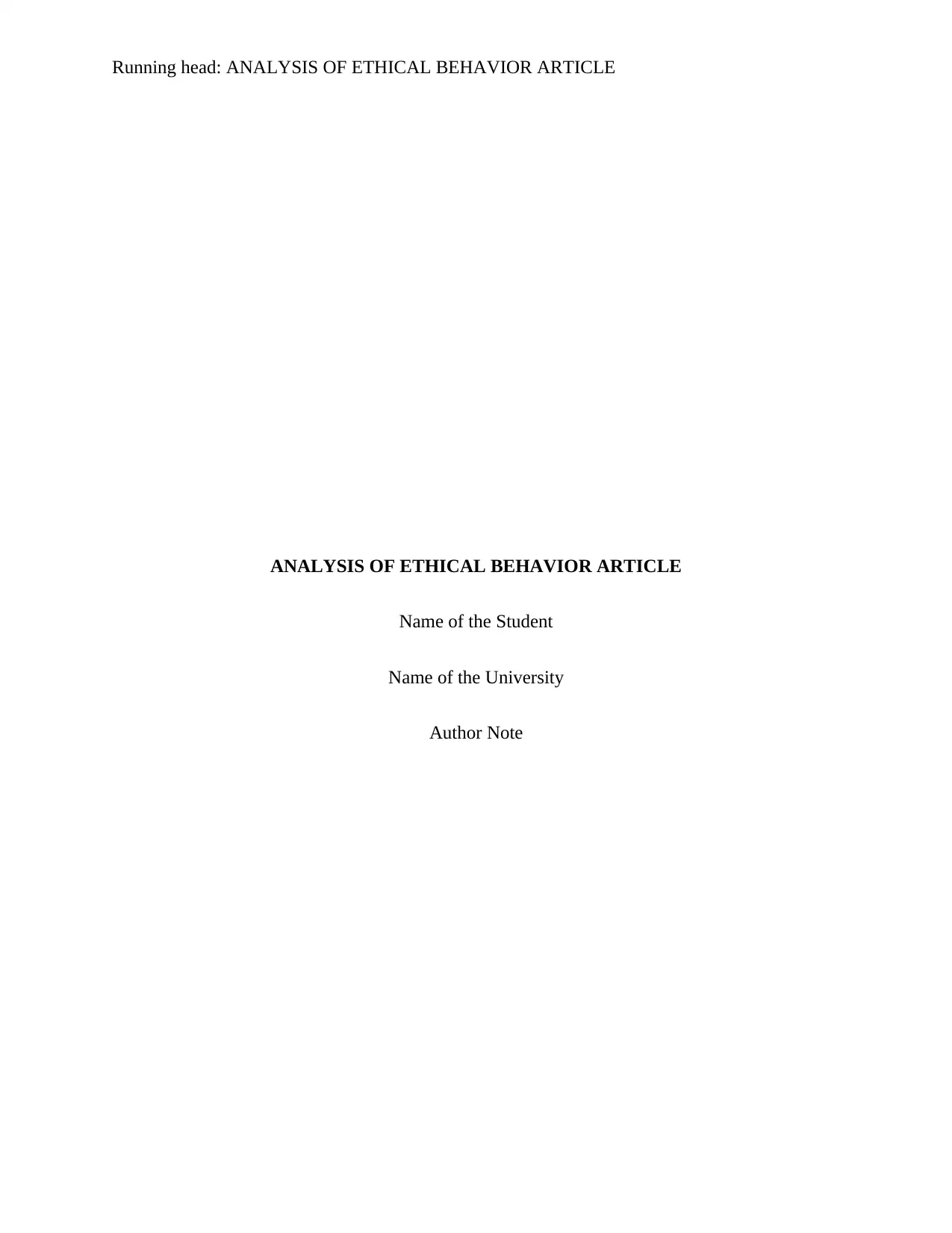
Running head: ANALYSIS OF ETHICAL BEHAVIOR ARTICLE
ANALYSIS OF ETHICAL BEHAVIOR ARTICLE
Name of the Student
Name of the University
Author Note
ANALYSIS OF ETHICAL BEHAVIOR ARTICLE
Name of the Student
Name of the University
Author Note
Paraphrase This Document
Need a fresh take? Get an instant paraphrase of this document with our AI Paraphraser
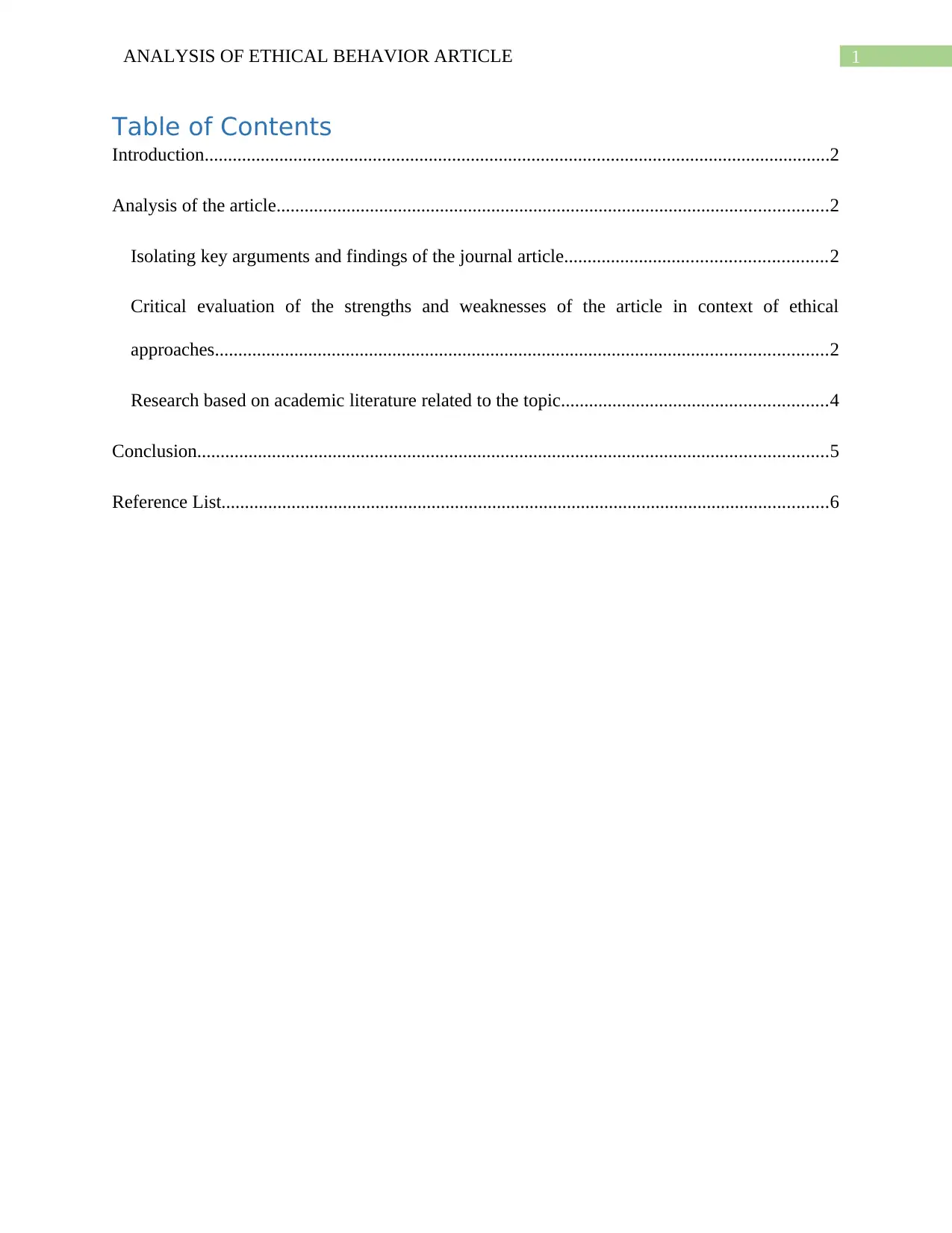
1ANALYSIS OF ETHICAL BEHAVIOR ARTICLE
Table of Contents
Introduction......................................................................................................................................2
Analysis of the article......................................................................................................................2
Isolating key arguments and findings of the journal article........................................................2
Critical evaluation of the strengths and weaknesses of the article in context of ethical
approaches...................................................................................................................................2
Research based on academic literature related to the topic.........................................................4
Conclusion.......................................................................................................................................5
Reference List..................................................................................................................................6
Table of Contents
Introduction......................................................................................................................................2
Analysis of the article......................................................................................................................2
Isolating key arguments and findings of the journal article........................................................2
Critical evaluation of the strengths and weaknesses of the article in context of ethical
approaches...................................................................................................................................2
Research based on academic literature related to the topic.........................................................4
Conclusion.......................................................................................................................................5
Reference List..................................................................................................................................6
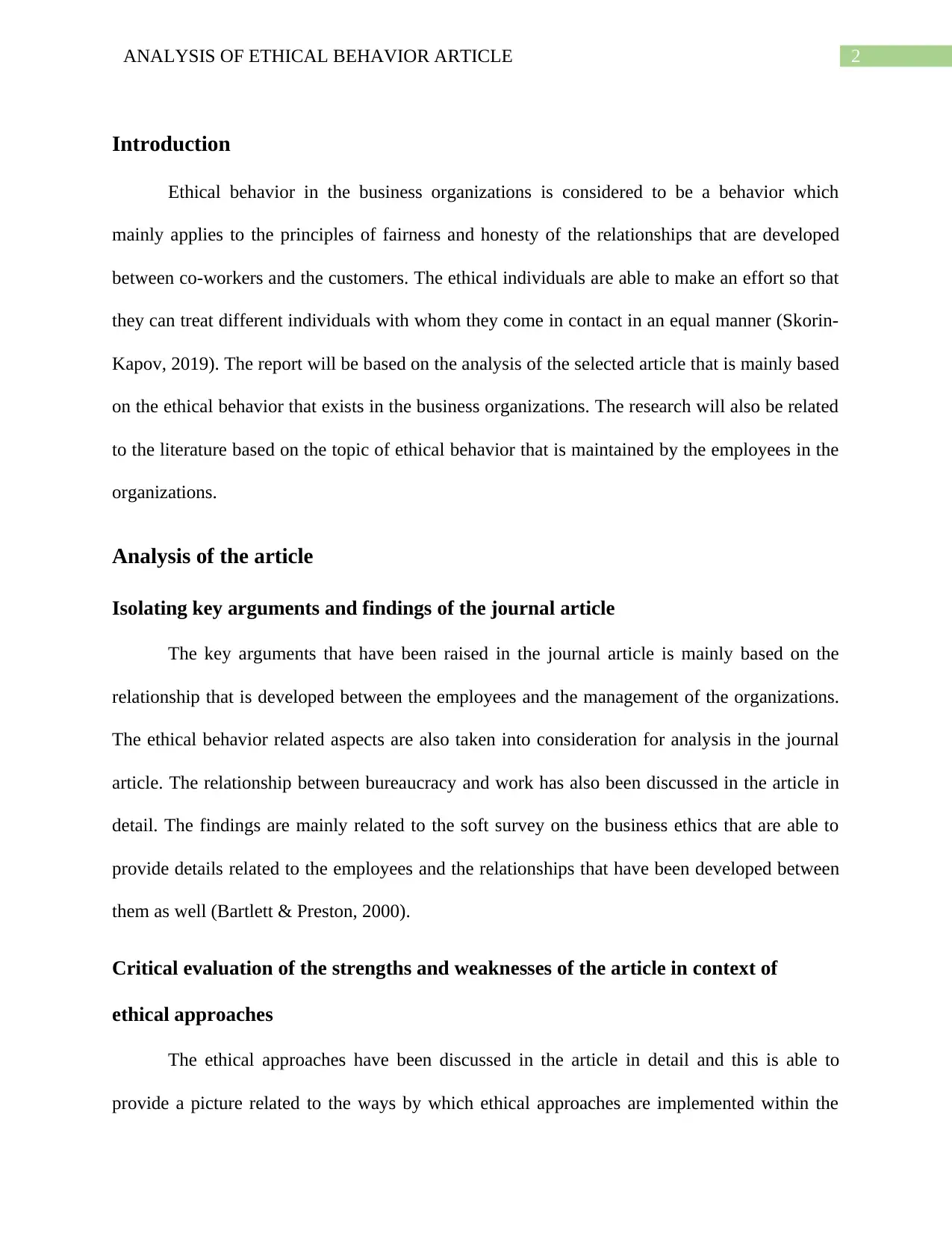
2ANALYSIS OF ETHICAL BEHAVIOR ARTICLE
Introduction
Ethical behavior in the business organizations is considered to be a behavior which
mainly applies to the principles of fairness and honesty of the relationships that are developed
between co-workers and the customers. The ethical individuals are able to make an effort so that
they can treat different individuals with whom they come in contact in an equal manner (Skorin-
Kapov, 2019). The report will be based on the analysis of the selected article that is mainly based
on the ethical behavior that exists in the business organizations. The research will also be related
to the literature based on the topic of ethical behavior that is maintained by the employees in the
organizations.
Analysis of the article
Isolating key arguments and findings of the journal article
The key arguments that have been raised in the journal article is mainly based on the
relationship that is developed between the employees and the management of the organizations.
The ethical behavior related aspects are also taken into consideration for analysis in the journal
article. The relationship between bureaucracy and work has also been discussed in the article in
detail. The findings are mainly related to the soft survey on the business ethics that are able to
provide details related to the employees and the relationships that have been developed between
them as well (Bartlett & Preston, 2000).
Critical evaluation of the strengths and weaknesses of the article in context of
ethical approaches
The ethical approaches have been discussed in the article in detail and this is able to
provide a picture related to the ways by which ethical approaches are implemented within the
Introduction
Ethical behavior in the business organizations is considered to be a behavior which
mainly applies to the principles of fairness and honesty of the relationships that are developed
between co-workers and the customers. The ethical individuals are able to make an effort so that
they can treat different individuals with whom they come in contact in an equal manner (Skorin-
Kapov, 2019). The report will be based on the analysis of the selected article that is mainly based
on the ethical behavior that exists in the business organizations. The research will also be related
to the literature based on the topic of ethical behavior that is maintained by the employees in the
organizations.
Analysis of the article
Isolating key arguments and findings of the journal article
The key arguments that have been raised in the journal article is mainly based on the
relationship that is developed between the employees and the management of the organizations.
The ethical behavior related aspects are also taken into consideration for analysis in the journal
article. The relationship between bureaucracy and work has also been discussed in the article in
detail. The findings are mainly related to the soft survey on the business ethics that are able to
provide details related to the employees and the relationships that have been developed between
them as well (Bartlett & Preston, 2000).
Critical evaluation of the strengths and weaknesses of the article in context of
ethical approaches
The ethical approaches have been discussed in the article in detail and this is able to
provide a picture related to the ways by which ethical approaches are implemented within the
⊘ This is a preview!⊘
Do you want full access?
Subscribe today to unlock all pages.

Trusted by 1+ million students worldwide
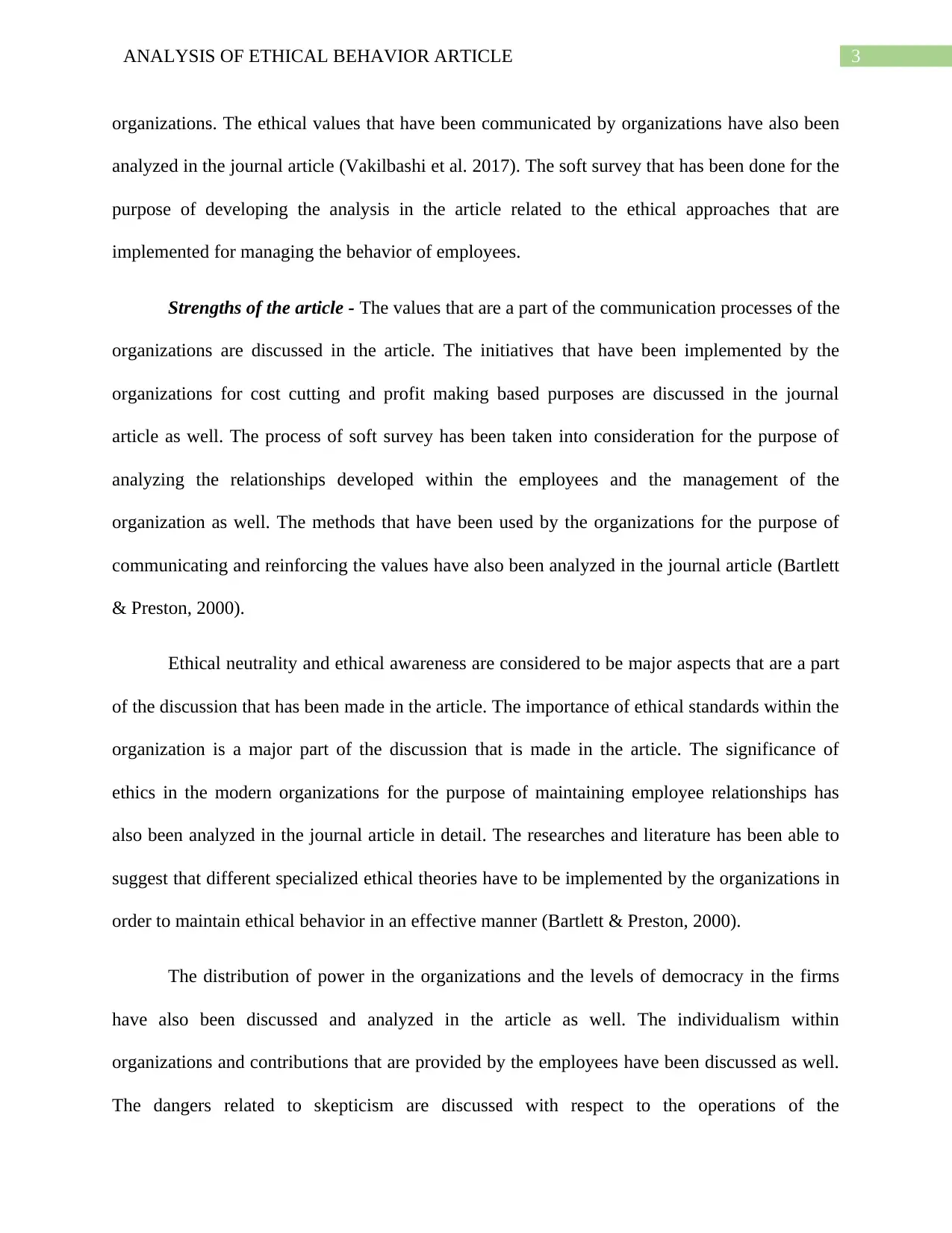
3ANALYSIS OF ETHICAL BEHAVIOR ARTICLE
organizations. The ethical values that have been communicated by organizations have also been
analyzed in the journal article (Vakilbashi et al. 2017). The soft survey that has been done for the
purpose of developing the analysis in the article related to the ethical approaches that are
implemented for managing the behavior of employees.
Strengths of the article - The values that are a part of the communication processes of the
organizations are discussed in the article. The initiatives that have been implemented by the
organizations for cost cutting and profit making based purposes are discussed in the journal
article as well. The process of soft survey has been taken into consideration for the purpose of
analyzing the relationships developed within the employees and the management of the
organization as well. The methods that have been used by the organizations for the purpose of
communicating and reinforcing the values have also been analyzed in the journal article (Bartlett
& Preston, 2000).
Ethical neutrality and ethical awareness are considered to be major aspects that are a part
of the discussion that has been made in the article. The importance of ethical standards within the
organization is a major part of the discussion that is made in the article. The significance of
ethics in the modern organizations for the purpose of maintaining employee relationships has
also been analyzed in the journal article in detail. The researches and literature has been able to
suggest that different specialized ethical theories have to be implemented by the organizations in
order to maintain ethical behavior in an effective manner (Bartlett & Preston, 2000).
The distribution of power in the organizations and the levels of democracy in the firms
have also been discussed and analyzed in the article as well. The individualism within
organizations and contributions that are provided by the employees have been discussed as well.
The dangers related to skepticism are discussed with respect to the operations of the
organizations. The ethical values that have been communicated by organizations have also been
analyzed in the journal article (Vakilbashi et al. 2017). The soft survey that has been done for the
purpose of developing the analysis in the article related to the ethical approaches that are
implemented for managing the behavior of employees.
Strengths of the article - The values that are a part of the communication processes of the
organizations are discussed in the article. The initiatives that have been implemented by the
organizations for cost cutting and profit making based purposes are discussed in the journal
article as well. The process of soft survey has been taken into consideration for the purpose of
analyzing the relationships developed within the employees and the management of the
organization as well. The methods that have been used by the organizations for the purpose of
communicating and reinforcing the values have also been analyzed in the journal article (Bartlett
& Preston, 2000).
Ethical neutrality and ethical awareness are considered to be major aspects that are a part
of the discussion that has been made in the article. The importance of ethical standards within the
organization is a major part of the discussion that is made in the article. The significance of
ethics in the modern organizations for the purpose of maintaining employee relationships has
also been analyzed in the journal article in detail. The researches and literature has been able to
suggest that different specialized ethical theories have to be implemented by the organizations in
order to maintain ethical behavior in an effective manner (Bartlett & Preston, 2000).
The distribution of power in the organizations and the levels of democracy in the firms
have also been discussed and analyzed in the article as well. The individualism within
organizations and contributions that are provided by the employees have been discussed as well.
The dangers related to skepticism are discussed with respect to the operations of the
Paraphrase This Document
Need a fresh take? Get an instant paraphrase of this document with our AI Paraphraser
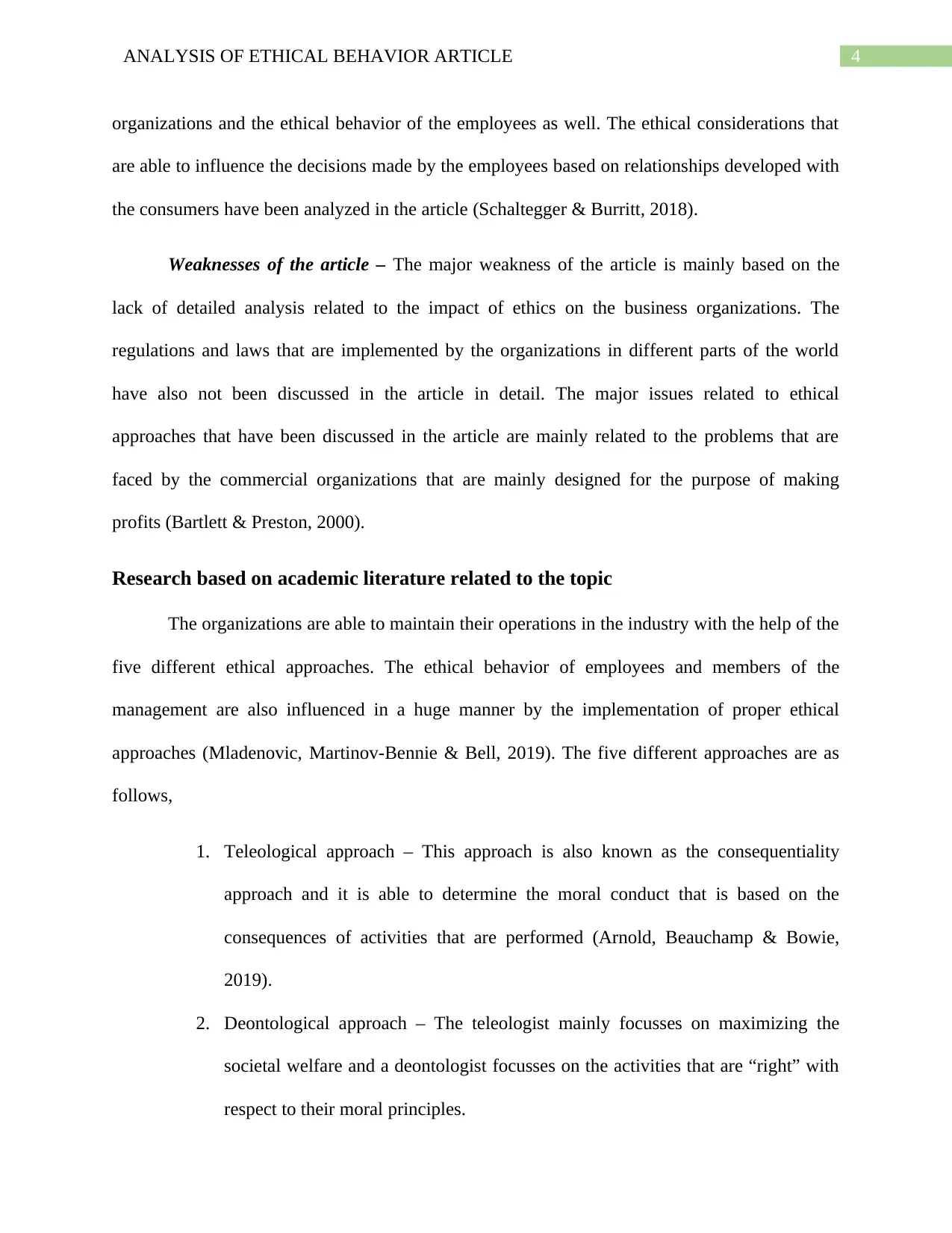
4ANALYSIS OF ETHICAL BEHAVIOR ARTICLE
organizations and the ethical behavior of the employees as well. The ethical considerations that
are able to influence the decisions made by the employees based on relationships developed with
the consumers have been analyzed in the article (Schaltegger & Burritt, 2018).
Weaknesses of the article – The major weakness of the article is mainly based on the
lack of detailed analysis related to the impact of ethics on the business organizations. The
regulations and laws that are implemented by the organizations in different parts of the world
have also not been discussed in the article in detail. The major issues related to ethical
approaches that have been discussed in the article are mainly related to the problems that are
faced by the commercial organizations that are mainly designed for the purpose of making
profits (Bartlett & Preston, 2000).
Research based on academic literature related to the topic
The organizations are able to maintain their operations in the industry with the help of the
five different ethical approaches. The ethical behavior of employees and members of the
management are also influenced in a huge manner by the implementation of proper ethical
approaches (Mladenovic, Martinov-Bennie & Bell, 2019). The five different approaches are as
follows,
1. Teleological approach – This approach is also known as the consequentiality
approach and it is able to determine the moral conduct that is based on the
consequences of activities that are performed (Arnold, Beauchamp & Bowie,
2019).
2. Deontological approach – The teleologist mainly focusses on maximizing the
societal welfare and a deontologist focusses on the activities that are “right” with
respect to their moral principles.
organizations and the ethical behavior of the employees as well. The ethical considerations that
are able to influence the decisions made by the employees based on relationships developed with
the consumers have been analyzed in the article (Schaltegger & Burritt, 2018).
Weaknesses of the article – The major weakness of the article is mainly based on the
lack of detailed analysis related to the impact of ethics on the business organizations. The
regulations and laws that are implemented by the organizations in different parts of the world
have also not been discussed in the article in detail. The major issues related to ethical
approaches that have been discussed in the article are mainly related to the problems that are
faced by the commercial organizations that are mainly designed for the purpose of making
profits (Bartlett & Preston, 2000).
Research based on academic literature related to the topic
The organizations are able to maintain their operations in the industry with the help of the
five different ethical approaches. The ethical behavior of employees and members of the
management are also influenced in a huge manner by the implementation of proper ethical
approaches (Mladenovic, Martinov-Bennie & Bell, 2019). The five different approaches are as
follows,
1. Teleological approach – This approach is also known as the consequentiality
approach and it is able to determine the moral conduct that is based on the
consequences of activities that are performed (Arnold, Beauchamp & Bowie,
2019).
2. Deontological approach – The teleologist mainly focusses on maximizing the
societal welfare and a deontologist focusses on the activities that are “right” with
respect to their moral principles.
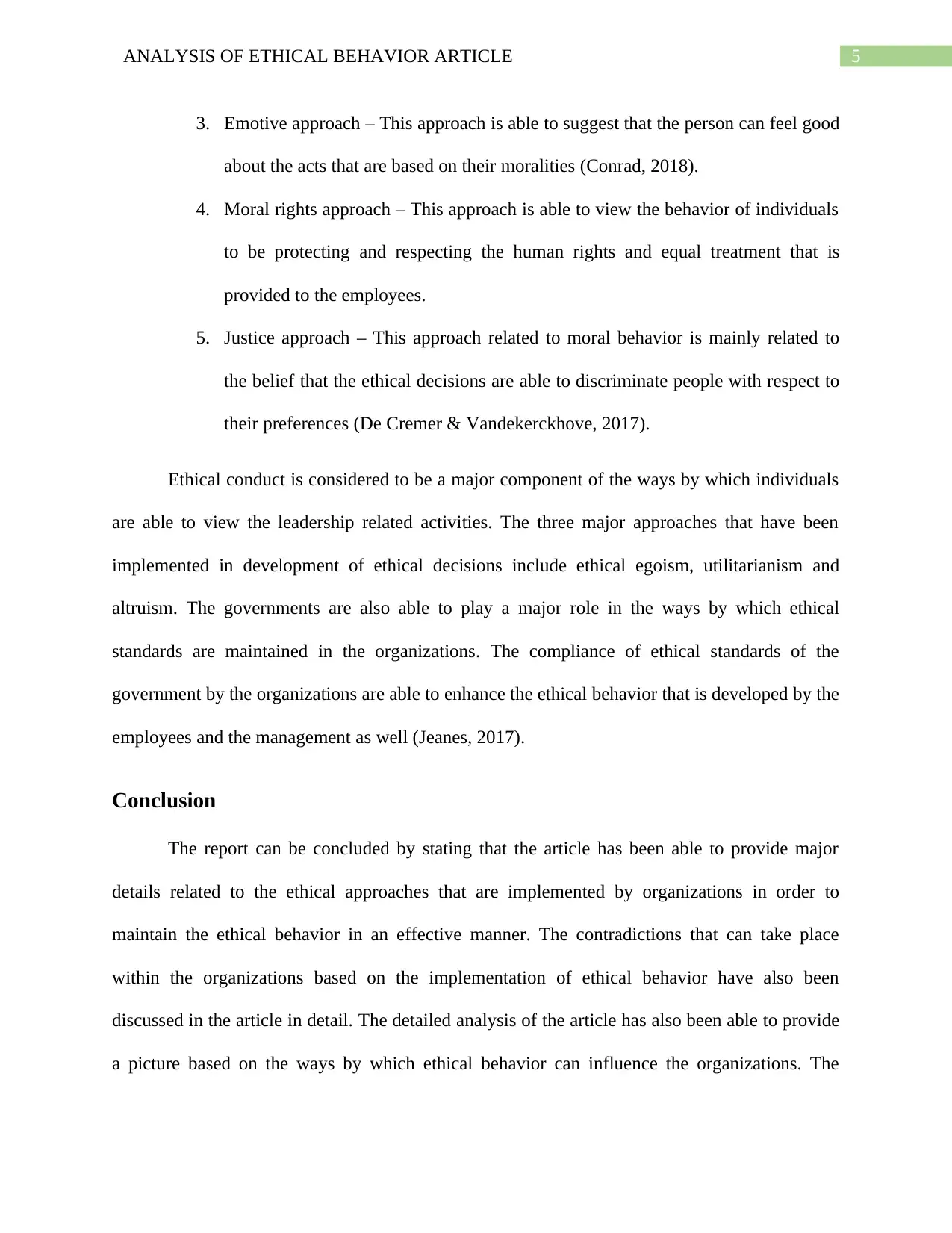
5ANALYSIS OF ETHICAL BEHAVIOR ARTICLE
3. Emotive approach – This approach is able to suggest that the person can feel good
about the acts that are based on their moralities (Conrad, 2018).
4. Moral rights approach – This approach is able to view the behavior of individuals
to be protecting and respecting the human rights and equal treatment that is
provided to the employees.
5. Justice approach – This approach related to moral behavior is mainly related to
the belief that the ethical decisions are able to discriminate people with respect to
their preferences (De Cremer & Vandekerckhove, 2017).
Ethical conduct is considered to be a major component of the ways by which individuals
are able to view the leadership related activities. The three major approaches that have been
implemented in development of ethical decisions include ethical egoism, utilitarianism and
altruism. The governments are also able to play a major role in the ways by which ethical
standards are maintained in the organizations. The compliance of ethical standards of the
government by the organizations are able to enhance the ethical behavior that is developed by the
employees and the management as well (Jeanes, 2017).
Conclusion
The report can be concluded by stating that the article has been able to provide major
details related to the ethical approaches that are implemented by organizations in order to
maintain the ethical behavior in an effective manner. The contradictions that can take place
within the organizations based on the implementation of ethical behavior have also been
discussed in the article in detail. The detailed analysis of the article has also been able to provide
a picture based on the ways by which ethical behavior can influence the organizations. The
3. Emotive approach – This approach is able to suggest that the person can feel good
about the acts that are based on their moralities (Conrad, 2018).
4. Moral rights approach – This approach is able to view the behavior of individuals
to be protecting and respecting the human rights and equal treatment that is
provided to the employees.
5. Justice approach – This approach related to moral behavior is mainly related to
the belief that the ethical decisions are able to discriminate people with respect to
their preferences (De Cremer & Vandekerckhove, 2017).
Ethical conduct is considered to be a major component of the ways by which individuals
are able to view the leadership related activities. The three major approaches that have been
implemented in development of ethical decisions include ethical egoism, utilitarianism and
altruism. The governments are also able to play a major role in the ways by which ethical
standards are maintained in the organizations. The compliance of ethical standards of the
government by the organizations are able to enhance the ethical behavior that is developed by the
employees and the management as well (Jeanes, 2017).
Conclusion
The report can be concluded by stating that the article has been able to provide major
details related to the ethical approaches that are implemented by organizations in order to
maintain the ethical behavior in an effective manner. The contradictions that can take place
within the organizations based on the implementation of ethical behavior have also been
discussed in the article in detail. The detailed analysis of the article has also been able to provide
a picture based on the ways by which ethical behavior can influence the organizations. The
⊘ This is a preview!⊘
Do you want full access?
Subscribe today to unlock all pages.

Trusted by 1+ million students worldwide
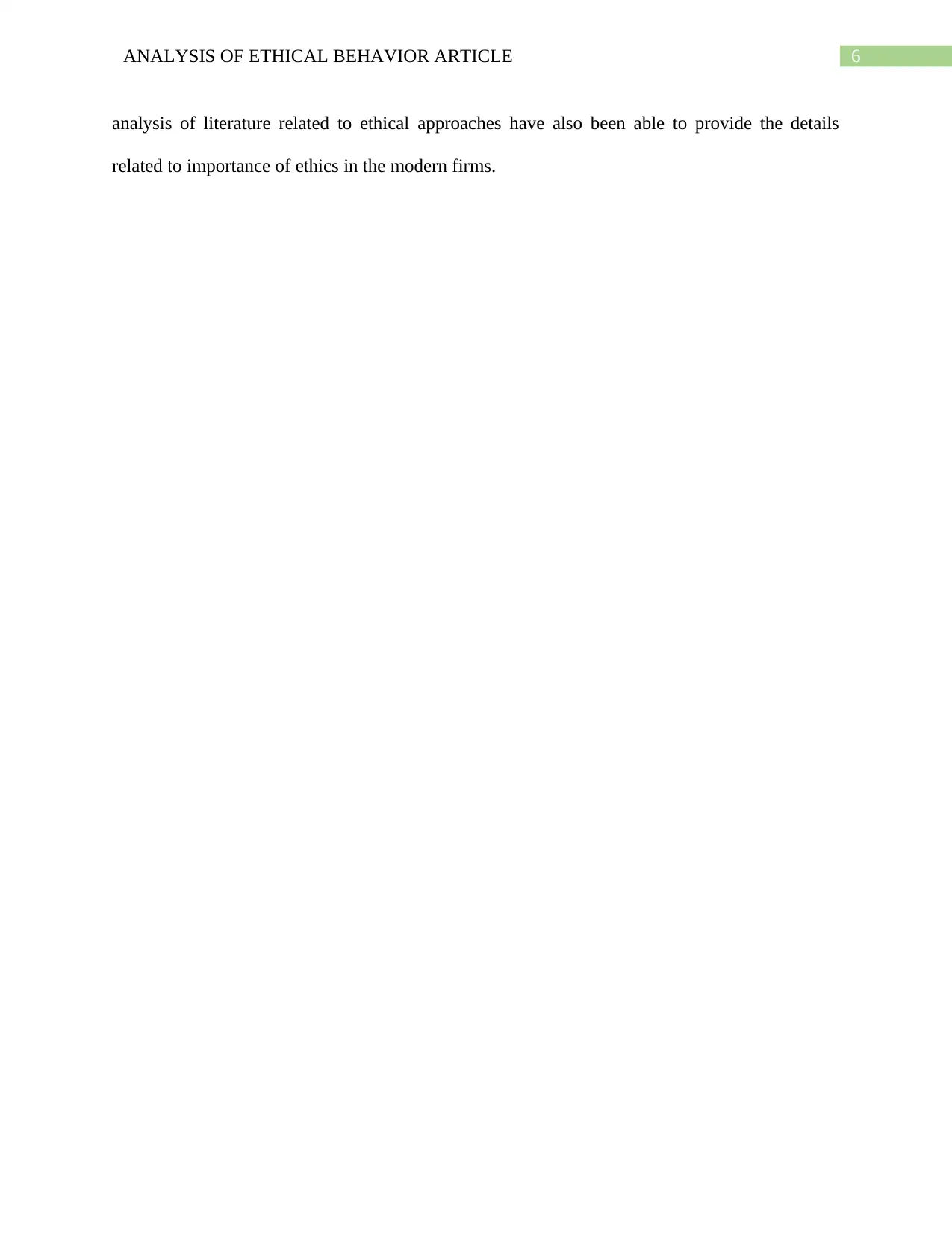
6ANALYSIS OF ETHICAL BEHAVIOR ARTICLE
analysis of literature related to ethical approaches have also been able to provide the details
related to importance of ethics in the modern firms.
analysis of literature related to ethical approaches have also been able to provide the details
related to importance of ethics in the modern firms.
Paraphrase This Document
Need a fresh take? Get an instant paraphrase of this document with our AI Paraphraser
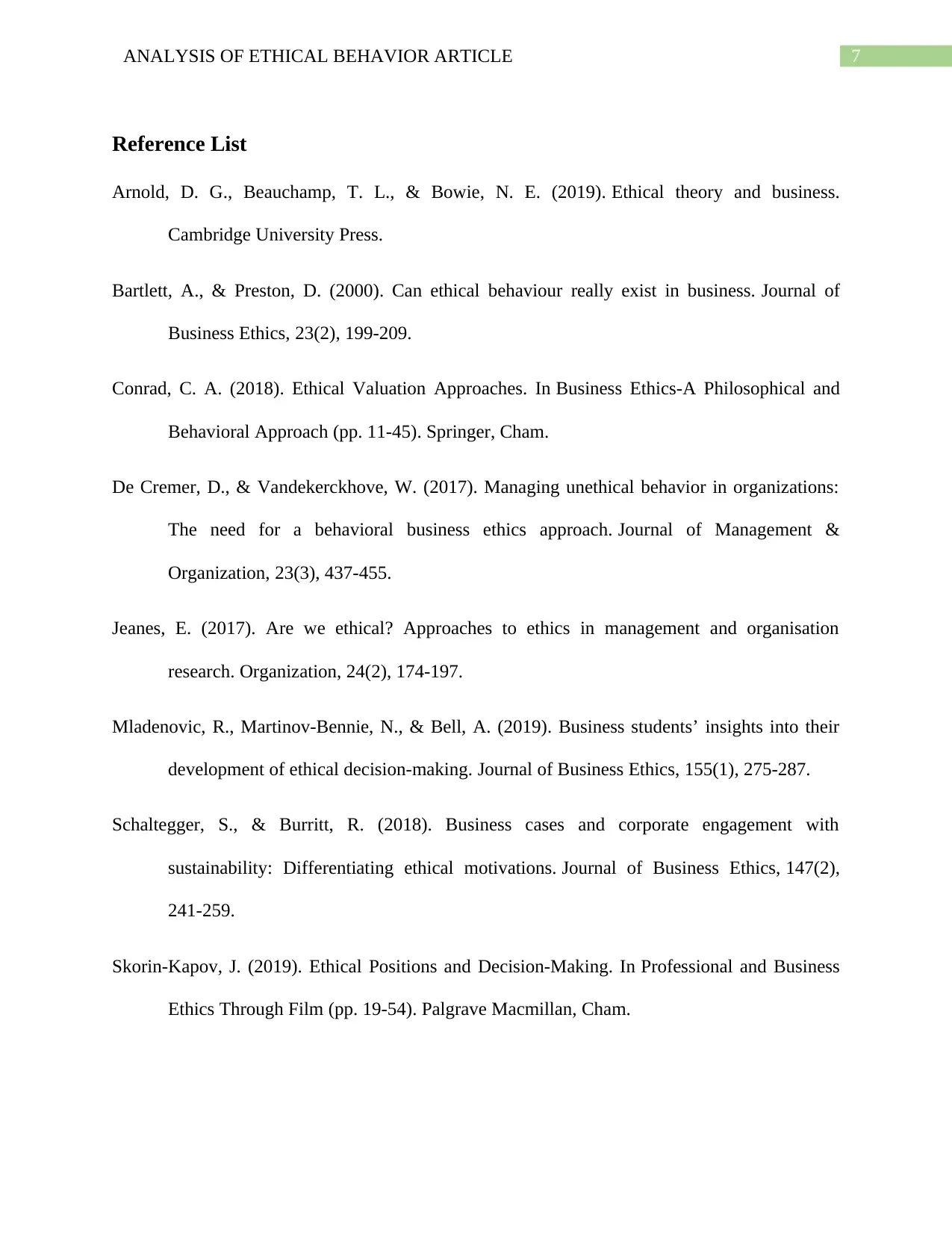
7ANALYSIS OF ETHICAL BEHAVIOR ARTICLE
Reference List
Arnold, D. G., Beauchamp, T. L., & Bowie, N. E. (2019). Ethical theory and business.
Cambridge University Press.
Bartlett, A., & Preston, D. (2000). Can ethical behaviour really exist in business. Journal of
Business Ethics, 23(2), 199-209.
Conrad, C. A. (2018). Ethical Valuation Approaches. In Business Ethics-A Philosophical and
Behavioral Approach (pp. 11-45). Springer, Cham.
De Cremer, D., & Vandekerckhove, W. (2017). Managing unethical behavior in organizations:
The need for a behavioral business ethics approach. Journal of Management &
Organization, 23(3), 437-455.
Jeanes, E. (2017). Are we ethical? Approaches to ethics in management and organisation
research. Organization, 24(2), 174-197.
Mladenovic, R., Martinov-Bennie, N., & Bell, A. (2019). Business students’ insights into their
development of ethical decision-making. Journal of Business Ethics, 155(1), 275-287.
Schaltegger, S., & Burritt, R. (2018). Business cases and corporate engagement with
sustainability: Differentiating ethical motivations. Journal of Business Ethics, 147(2),
241-259.
Skorin-Kapov, J. (2019). Ethical Positions and Decision-Making. In Professional and Business
Ethics Through Film (pp. 19-54). Palgrave Macmillan, Cham.
Reference List
Arnold, D. G., Beauchamp, T. L., & Bowie, N. E. (2019). Ethical theory and business.
Cambridge University Press.
Bartlett, A., & Preston, D. (2000). Can ethical behaviour really exist in business. Journal of
Business Ethics, 23(2), 199-209.
Conrad, C. A. (2018). Ethical Valuation Approaches. In Business Ethics-A Philosophical and
Behavioral Approach (pp. 11-45). Springer, Cham.
De Cremer, D., & Vandekerckhove, W. (2017). Managing unethical behavior in organizations:
The need for a behavioral business ethics approach. Journal of Management &
Organization, 23(3), 437-455.
Jeanes, E. (2017). Are we ethical? Approaches to ethics in management and organisation
research. Organization, 24(2), 174-197.
Mladenovic, R., Martinov-Bennie, N., & Bell, A. (2019). Business students’ insights into their
development of ethical decision-making. Journal of Business Ethics, 155(1), 275-287.
Schaltegger, S., & Burritt, R. (2018). Business cases and corporate engagement with
sustainability: Differentiating ethical motivations. Journal of Business Ethics, 147(2),
241-259.
Skorin-Kapov, J. (2019). Ethical Positions and Decision-Making. In Professional and Business
Ethics Through Film (pp. 19-54). Palgrave Macmillan, Cham.
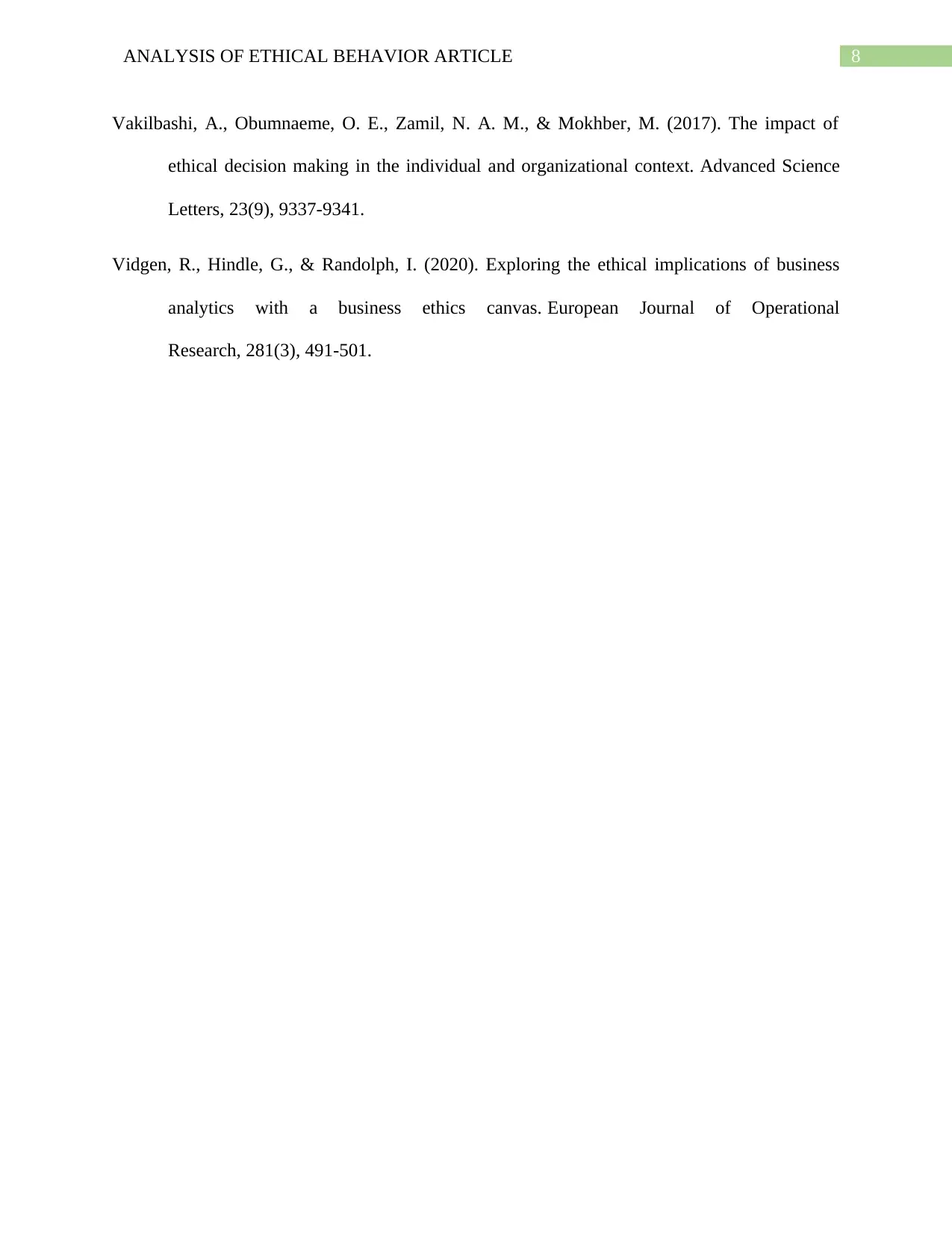
8ANALYSIS OF ETHICAL BEHAVIOR ARTICLE
Vakilbashi, A., Obumnaeme, O. E., Zamil, N. A. M., & Mokhber, M. (2017). The impact of
ethical decision making in the individual and organizational context. Advanced Science
Letters, 23(9), 9337-9341.
Vidgen, R., Hindle, G., & Randolph, I. (2020). Exploring the ethical implications of business
analytics with a business ethics canvas. European Journal of Operational
Research, 281(3), 491-501.
Vakilbashi, A., Obumnaeme, O. E., Zamil, N. A. M., & Mokhber, M. (2017). The impact of
ethical decision making in the individual and organizational context. Advanced Science
Letters, 23(9), 9337-9341.
Vidgen, R., Hindle, G., & Randolph, I. (2020). Exploring the ethical implications of business
analytics with a business ethics canvas. European Journal of Operational
Research, 281(3), 491-501.
⊘ This is a preview!⊘
Do you want full access?
Subscribe today to unlock all pages.

Trusted by 1+ million students worldwide
1 out of 9
Related Documents
Your All-in-One AI-Powered Toolkit for Academic Success.
+13062052269
info@desklib.com
Available 24*7 on WhatsApp / Email
![[object Object]](/_next/static/media/star-bottom.7253800d.svg)
Unlock your academic potential
Copyright © 2020–2025 A2Z Services. All Rights Reserved. Developed and managed by ZUCOL.





